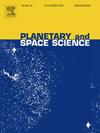An estimate of resident time of the Oort Cloud new comets in planetary region
IF 1.7
4区 物理与天体物理
Q3 ASTRONOMY & ASTROPHYSICS
引用次数: 0
Abstract
We describe the result of our numerical orbit simulation which traces dynamical evolution of new comets coming from the Oort Cloud. We combine two dynamical models for this purpose. The first one is semi-analytic, and it models an evolving comet cloud under galactic tide and encounters with nearby stars. The second one numerically deals with planetary perturbation in the planetary region. Although our study does not include physical effects such as fading or disintegration of comets, we found that typical dynamical resident time of the comets in the planetary region is about years. We also found that the so-called planet barrier works when the initial orbital inclination of the comets is small. A numerical result concerning the temporary transition of the comets into other small body populations such as transneptunian objects or Centaurs is discussed.
奥尔特云新彗星在行星区驻留时间的估算
我们描述了数值轨道模拟的结果,该模拟追踪了来自奥尔特云的新彗星的动态演变。为此,我们结合了两个动力学模型。第一个模型是半解析模型,它模拟了在银河系潮汐作用下不断演变的彗星云,以及与附近恒星的相遇。第二个模型以数值方式处理行星区域的行星扰动。虽然我们的研究并不包括彗星消逝或解体等物理效应,但我们发现彗星在行星区域的典型动态驻留时间约为 108 年。我们还发现,当彗星的初始轨道倾角较小时,所谓的行星屏障就会起作用。我们还讨论了关于彗星暂时过渡到其他小天体群(如超海王星天体或半人马座)的数值结果。
本文章由计算机程序翻译,如有差异,请以英文原文为准。
求助全文
约1分钟内获得全文
求助全文
来源期刊

Planetary and Space Science
地学天文-天文与天体物理
CiteScore
5.40
自引率
4.20%
发文量
126
审稿时长
15 weeks
期刊介绍:
Planetary and Space Science publishes original articles as well as short communications (letters). Ground-based and space-borne instrumentation and laboratory simulation of solar system processes are included. The following fields of planetary and solar system research are covered:
• Celestial mechanics, including dynamical evolution of the solar system, gravitational captures and resonances, relativistic effects, tracking and dynamics
• Cosmochemistry and origin, including all aspects of the formation and initial physical and chemical evolution of the solar system
• Terrestrial planets and satellites, including the physics of the interiors, geology and morphology of the surfaces, tectonics, mineralogy and dating
• Outer planets and satellites, including formation and evolution, remote sensing at all wavelengths and in situ measurements
• Planetary atmospheres, including formation and evolution, circulation and meteorology, boundary layers, remote sensing and laboratory simulation
• Planetary magnetospheres and ionospheres, including origin of magnetic fields, magnetospheric plasma and radiation belts, and their interaction with the sun, the solar wind and satellites
• Small bodies, dust and rings, including asteroids, comets and zodiacal light and their interaction with the solar radiation and the solar wind
• Exobiology, including origin of life, detection of planetary ecosystems and pre-biological phenomena in the solar system and laboratory simulations
• Extrasolar systems, including the detection and/or the detectability of exoplanets and planetary systems, their formation and evolution, the physical and chemical properties of the exoplanets
• History of planetary and space research
 求助内容:
求助内容: 应助结果提醒方式:
应助结果提醒方式:


